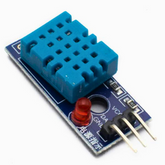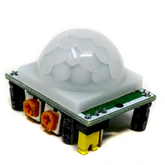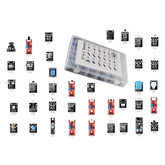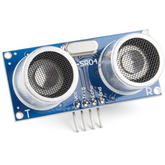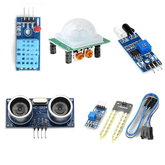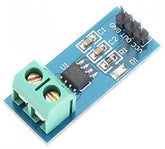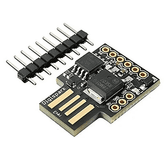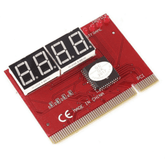Sensor
Summary
What is a Sensor?
A sensor is a device that detects changes in its environment and responds by generating a signal. Sensors are known as transducers because they convert one type of energy, such as heat, light, or motion, into another, typically an electrical signal.
How does it actually operate, then? Your skin, hearing, and eyes allow you to detect your environment. A transducer works in the same way, except for machines and robots. A sensor detects a physical occurrence, such as an increase in temperature or movement nearby, and converts it into a signal that can be shown on a screen, stored, or used to initiate a response in another system.

For example, think about how your smartphone adjusts brightness based on the light around you. The ambient light module is in operation there. Or how your car beeps when you're backing up too close to something—that’s a distance transducer in action.
In short, transducers are used to measure environmental factors like temperature, pressure, humidity, distance, and more. They help systems make decisions based on real-world conditions.
Main Concepts of Sensors are:
- Detect the presence or change in energy
- Respond to that energy change
- Convert it into a signal that we or a machine can understand
Transducers are everywhere, from simple electronics and robotics to advanced aerospace systems, and they play a vital role in modern automation, data collection, and smart technology.
Also Read The Must-Know Types of Sensors in IoT for Every IoT Projects
Working Principle of Sensor

The working of a sensor starts with the receptor, which detects physical input such as temperature, light, or motion. This input is then passed to the transduction stage, where it is converted into another form of energy, typically an electrical signal.
The signal conditioning stage follows, where the converted signal is amplified, filtered, and digitized to ensure accuracy and stability. After conditioning, the signal moves to the output stage, where it is transformed into a readable format such as voltage, current, frequency, or digital code.
In many cases, the sensor also compares input and output signals, quantifies the change, and generates an appropriate response. Some sensing devices include feedback loops to maintain accuracy and adapt to environmental variations.
Why Are Sensors Used?
A sensor is used to detect a parameter in one form and report it in another form of energy, usually as an electrical or digital signal. For example, a pressure measurement device might detect pressure, which is a mechanical form of energy that is converted into electricity for display on a remote gauge.
Without the use of sensors, there would be no automation. The sensing modules are essential components in modern systems and technologies.
They are pervasively embedded in our bodies, automobiles, airplanes, cellular telephones, radios, chemical plants, industrial plants, and many other applications.
What is an IoT Sensor?

A smart device known as an Internet of Things or IoT sensor enables machines to "see," "hear," or "feel" their environment. These transducers collect data from the environment, like temperature, air quality, motion, or water levels, and send it over the internet using WiFi, Bluetooth, 5G, or other networks.
You can think of IoT sensors as the "senses" of smart devices. They form the bridge between the physical world and the digital world.
These IoT modules are used in smart cities (traffic lights, air quality monitors), healthcare (remote patient monitoring), manufacturing (machine health), agriculture (climate control), and more. By enabling automation and real-time decision-making, they boost efficiency, improve safety, reduce errors, and support predictive maintenance.
IoT sensors play a key role in modern technology, helping industries and cities run smarter, safer, and more efficiently.
Explore the basics of IoT with easy examples in this blog - What is IoT?
Classification of Sensors
Passive Sensors
A passive sensor is a device that detects things like light, heat, vibrations, or radiation, but it doesn’t send out any signal of its own. It just quietly picks up what’s already around it.
You’ll often find these passive modules in places that are difficult or dangerous for people to go, like outer space, deep under the ocean, or inside hazardous areas.
To collect information, these transducers are usually placed on satellites, drones, submarines, or even on buildings. They help us do things like map the earth, find natural resources, or study the weather and air.
Examples of Passive Sensors include:
- Thermal sensors
- Infrared sensors
- Photographic Transducers
- Seismic Modules
- Chemical sensors
- Electric field Modules
Active Sensors
An active sensor is a device that sends out its own signal into the environment and then measures how that signal bounces back. It needs power to work, unlike passive modules that just detect what’s already around.
These transducers are useful in dark or low-light conditions, and they can measure distance, speed, and direction with high accuracy. Like an ultrasonic distance module sends out a sound wave. When the wave hits an object, it bounces back. The detector calculates the time it took to return to figure out how far the object is.
Examples of Active Sensors Include:
- Ultrasonic Sensors
- Radar Modules
- LDR Sensor
- Infrared Sensors (Active Type)
- SONAR (Sound Navigation and Ranging)
- GPS Module
Learn About Arduino Sensor Types with Real Examples
18 Types of Sensors
Humidity Sensors
A humidity sensor, also called a hygrometer, is a small device that tells us how much moisture or water vapor is in the air.
Just like a thermometer measures temperature, a humidity gauge measures how “humid” or damp the air feels.
These transducers are super useful in everyday things, like keeping the right conditions in greenhouses, helping air conditioners know when to turn on, or even in medical devices that monitor patients’ breathing.

Working Principle of Humidity Sensor
These modules usually work using a material that absorbs moisture from the air. As the humidity changes, the material's electrical properties change, and this is used to calculate humidity levels. The most common type is the Relative Humidity (RH) gauge, which measures the percentage of water vapor in the air compared to the maximum it can hold at a given temperature.
Know the Simple Code and Setup for DHT11 Sensor Interfacing with ESP32.
Temperature Sensors
A temperature sensor measures the temperature of its environment and converts the information into a readable form, usually an electrical signal.
These sensing devices play a key role in monitoring heat levels in various applications—from everyday home appliances like refrigerators and air conditioners to industrial systems such as power plants and manufacturing machines.
Temperature detectors fall into two basic groups. The first is contact temperature modules, which include RTDs (Resistance Temperature Detectors), thermocouples, and thermistors. Second is Non-Contact Temperature probes, which detect temperature from a distance by sensing emitted infrared radiation.

Working Principle of Temperature Sensor
The way a temperature sensor works is simple yet powerful. It reacts to the heat energy present in its surroundings and changes its physical properties (such as resistance or voltage) based on the temperature.
This change is then interpreted by a microcontroller or processor to determine the exact temperature.
Understand the Basics of Temperature Sensor Working
Motion Sensors
A motion sensor is an electronic device that detects movement in its surroundings. In simple terms, it can see when someone enters or moves within a specific area and then sends a signal to perform an action, like turning on a light or triggering an alarm.

Working Principle of Motion Sensor
The most common type, PIR Sensors or Passive Infrared sensors, work by picking up heat or infrared radiation from people or objects. When someone enters the area, the heat pattern changes, and the module responds by sending a signal.
Other types, like ultrasonic modules, send out waves and detect motion based on how those waves bounce back. These detectors are widely used in automatic lights, alarms, and smart devices to make spaces more efficient and secure.
Learn the Science Behind PIR Sensors - A Simple Guide!
Pressure Sensors
A pressure sensor is a device that measures the force (pressure) of a gas or liquid and turns it into an electrical signal.
This signal can be used to monitor systems, control operations, or trigger alarms when pressure levels exceed set limits.
Or we can say it helps machines and devices "feel" the amount of force applied by a fluid, just like how our skin feels pressure when something touches it.

Working Principle of Pressure Sensor
A pressure sensor works by detecting pressure and turning it into an electrical signal. It usually has a thin diaphragm that bends when pressure is applied.
This bending is measured in different ways—like changes in resistance (piezoresistive), distance between plates (capacitive), or how much it stretches (strain gauge).
As the pressure changes, the diaphragm moves, and the sensor converts that movement into a voltage or digital signal. This signal tells us how much pressure is being applied. It's simple, quick, and useful for things like industrial machinery, medical devices, and cars.
Proximity Sensors
A proximity sensor can detect the presence of an object without any physical contact. Instead of touching the object, it senses when something comes close to it.
These detectors are commonly used in industries, automation systems, and even in smartphones. For example, in a mobile phone, the screen turns off when you bring it near your ear during a call; that's a proximity sensor at work.

Working Principle of Proximity Sensor
A proximity sensor works by detecting the presence of an object without any physical contact. It does this by generating a field or a signal, such as a magnetic field, electric field, or light beam.
When an object enters this field, it causes a change that the sensor can detect. This change is then converted into an electrical signal, which is sent to a control system for further action.
For example, inductive proximity modules detect metal objects by generating an electromagnetic field. When a metal object comes close, it disrupts this field, and the detector picks up the disturbance.
Capacitive sensors work similarly but can detect both metal and non-metal objects by sensing changes in electrical capacitance.
Optical sensors, like infrared, emit a light beam and detect reflections from nearby objects.
So, in a way, proximity modules are like the “spidey senses” of the tech world—quiet, sharp, and always ready to react.
Click Here to Learn Proximity Sensor Types
Water Level Sensors
A water level sensor is a device that helps measure how much water is present in a tank or container. It works by detecting the level of water and sending a signal to a control system or display.
These sensors come in different types, such as float-based, ultrasonic, and conductive. The water level modules are commonly used in home water tanks to avoid overflow, in irrigation systems to manage water use, and in factories to monitor liquid levels in machines.

Working Principle of Water Level Sensors
The working principle depends on the type of water level module.
In a conductive sensor, metal probes are placed at different heights inside the tank. When water touches a probe, it completes an electric circuit, which sends a signal indicating the water has reached that level.
Some detectors use ultrasonic waves. They send sound waves from the top of the tank, and when the wave bounces back from the water surface, the module calculates the distance. This reveals how much water is within.
Float sensors use a buoyant float that rises or falls with the water level. When it reaches certain positions, it triggers a switch.
Gas Sensors
A gas sensor is detects and measures the presence of specific gases in the air. Gas modules are widely used in everyday life and industries.
At home, they are found in smoke detectors and carbon monoxide alarms. In factories, they help detect gas leaks to prevent accidents.
In hospitals, they monitor oxygen levels for patients. Cities use them to check air pollution levels.

Working Principle of Gas Sensors
The working principle of a gas sensor is simple yet powerful. It detects the presence and concentration of gases by converting chemical or physical changes into electrical signals.
A metal oxide gas sensor changes its electrical resistance when it comes in contact with gases like carbon monoxide or methane. This resistance change is measured and used to determine the gas level.
Similarly, electrochemical gas sensors work like small batteries. When a gas enters the module, it causes a chemical reaction at the electrodes, which creates an electric current. This current is directly related to the gas concentration.
Infrared gas sensors use light to detect gases. They shine infrared light through the air and measure how much light is absorbed by the gas. The more gas present, the more light is absorbed.
Discover the Different Types of Gas Sensors and Their Workings!
Ultrasonic Sensors
An ultrasonic sensor is an electronic device that measures distance using sound waves above human hearing range.
This sensor is mainly used to calculate how far away the object is. These distance measurement modules work even in dark or dusty environments and don’t rely on the color or shape of the object.
Ultrasonic detectors are commonly used in cars for parking assistance, in robots for avoiding obstacles, and in industries for checking liquid levels in tanks.

Working Principle of Ultrasonic Sensors
The ultrasonic sensor works by sending out high-frequency sound waves through its transmitter. These sound waves travel through the air and reflect back when they hit an object. The module's receiver then picks up the reflected sound waves, also called echoes.
By measuring the time it takes for the sound to travel to the object and bounce back, the sensor calculates the distance to the object.
It uses a simple formula:
Distance = (Speed of Sound × Time) / 2
The division by 2 is because the sound travels to the object and then returns.
Understand Ultrasonic Sensors in Just 2 Minutes! Read Now!
Gyroscopes
A gyroscope is a device used to measure or maintain direction. It has a spinning disc inside that stays steady, even if the device moves around.
This is because of a science rule called the conservation of angular momentum, which means the spinning disc tries to keep its direction steady no matter what.
Gyroscopes are used in drones, self-driving cars, airplanes, and ships. You can also find them in smartphones, VR headsets, and gaming devices to sense movement and direction.

Working Principle of Gyroscopes
A gyroscope works on the principle of conservation of angular momentum. It contains a fast-spinning disc mounted on gimbals that allow free movement in multiple directions.
When the base moves, the spinning disc resists changes in its orientation, helping to detect direction or maintain balance.
This resistance creates a movement called precession, which helps measure the change in orientation.
Accelerometers
An accelerometer is a sensor that measures the acceleration or movement of an object. It detects how fast something is speeding up or slowing down in a particular direction. Inside the sensing devices, there’s usually a small mass placed on a piezoelectric material.
Accelerometers are found in smartphones to rotate screens and count steps, cars to deploy airbags, laptops to protect hard drives, and wearables to track workouts.

Working Principle of Accelerometers
It works by using a tiny weight inside the module, which moves when the device moves. This movement is measured and turned into an electrical signal. Accelerometers are commonly classified into two types:
Piezoelectric Accelerometer
It uses tiny crystals. These crystals are pressed or stretched when the device moves. This creates a small electric charge, which tells how fast or in which direction the object is moving.
Capacitive Accelerometer
This one uses tiny plates inside the sensor. When the device moves, the plates shift their position, changing the electric field between them. That change is measured to detect motion.
Air Quality Sensors
An air quality sensor is a device that measures how clean or polluted the air is. It can detect harmful gases like carbon dioxide (CO₂), carbon monoxide (CO), and tiny dust particles like PM2.5 and PM10 that we cannot see. Some detectors can also measure temperature, humidity, and even sunlight levels.
These modules are used in homes, schools, offices, and cities to check if the air is safe to breathe. They are often found in air purifiers and systems that bring in fresh air to keep indoor spaces healthy.

Working Principle of Air Quality Sensors
The air quality module works by pulling in air and checking for tiny harmful particles, like dust and smoke (called PM2.5). It also checks gases like carbon dioxide or carbon monoxide. Inside the transducer, special parts count these particles and gases.
The gauge sends this data to a small computer chip, which calculates a number called the Air Quality Index (AQI). This figure indicates if the air quality is good, average, or contaminated. Some sensors also check the temperature and humidity to give a better idea of the air quality.
Light Sensors
A light sensor is a device that can sense how bright or dark the light around it is. It helps measure the amount of light in a place.
Light or LDR modules help street lights turn on at night and off in the morning. In phones, they adjust screen brightness to save battery. They are also used in science projects and smart toys to react to light.

Working Principle of Light Sensors
A light sensor works by detecting the amount of light that falls on it. Inside the module, there is a special part called a photodiode or phototransistor that reacts to light.
When light hits this part, it creates a small electric current. The brighter the light, the more current is made. This current is then measured and turned into a number by the sensor, which tells us how bright the light is.
What is a Light Sensor? Find Out with Arduino Tips!
Vibration Sensors
A vibration sensor is a small device that can feel the shaking or movement of an object or machine. A machine may vibrate slightly while operating.
But if something inside it is broken or loose, it vibrates more than usual. The vibration module notices this and helps us know when there’s a problem.
Vibration sensors are used in in machines like fans, motors, engines, cars, airplanes, and even some buildings. By identifying issues before they worsen, this tiny transducer helps to keep both humans and machines safe.

Working Principle of Vibration Sensors
The working principle of a vibration module is based on detecting motion using special materials like piezoelectric crystals or tiny resistive parts.
Inside the module, there is a small weight called a seismic mass attached to a crystal. When the machine or object vibrates, the mass moves and puts pressure on the crystal.
This pressure causes the crystal to produce a small amount of electricity. The stronger the vibration, the more electricity it creates. The module then changes this electricity into a signal that shows how much vibration is happening.
Also, there are piezoresistive sensors that function somewhat differently. A thin beam in these modules is bent when the load moves. This bending changes the electrical resistance, and that change tells us how strong the vibration is.
Biomedical Sensors
Biomedical sensors help doctors and scientists check what’s happening inside our body. These detectors can detect things like body temperature, heart rate, oxygen levels, or sugar levels in the blood.
Biomedical modules are used in hospitals to monitor patients’ health while they are resting or during surgery. People also wear them in smartwatches or fitness bands to track steps, sleep, or exercise, and scientists use them in labs to test new medicines.
Unlock the Basics of Biomedical Sensors in This Guide - Click Here!

Working Principle of Biomedical Sensors
Biomedical sensors work by detecting signals from the human body, like heat, movement, or chemicals, and turning them into electrical signals that machines can read. Each type of probe is made to sense a specific thing.
For example, a heart rate sensor can detect the pulse, and a glucose sensor used by diabetic patients can sense sugar levels in the blood using chemical reactions.
Read the Complete Guide to Pulse Sensors and Their Types
Image sensors
An image sensor is an electronic device that captures light and turns it into a digital image. It is the primary part of cameras, phones, and other devices with photo and video capabilities.
When light enters the camera lens and hits the image detector, it changes the light into electrical signals. These signals are then processed to form a photo or video on the screen.
There are two main types of image sensors:
- CMOS (Complementary Metal-Oxide Semiconductor)
- CCD (Charge-Coupled Device)

Working Principle of Image Sensors
An image sensor works by converting light into electrical signals.
Light from the surroundings enters via the lens and strikes the image sensor when you take a picture. The transducer is made up of tiny parts called pixels. The light that strikes each pixel is captured.
This operates in two primary ways:
CMOS Sensor:
Each pixel has its own tiny circuit that quickly turns light into a voltage (electrical signal). These signals are then processed inside the sensor to create an image.
CCD Sensor:
The light is collected in the pixels and then sent one by one through a special circuit to convert it into a voltage. It can produce high-quality images, but it takes a little longer.
Once the light is turned into electrical signals, the camera's processor takes these signals and creates a digital picture you can see on a screen.
Chemical Sensors
A chemical sensor detects things like gases, liquids, or even particles in the air or body and turns that information into an electrical signal that we can read.
These modules are like the human nose or tongue, which help us "sense" chemicals using machines. These transducers have two main parts: a receptor, which spots the chemical and a transducer, which turns it into a signal.
Chemical sensors are used to check alcohol levels, harmful gases like CO or CO₂, glucose monitoring, air and water quality, and to detect smells or chemicals.

Working Principle of Chemical Sensors
The chemical measurement devices have two main parts – a receptor and a transducer. The receptor is the part that first reacts with the chemical. It has the ability to detect gases, liquids, and other materials.
When the chemical touches the receptor, it causes a small change. This change is picked up by the transducer, which turns it into an electrical signal.
That signal can then be shown on a screen or used to give a warning. This is how the chemical probe tells us that the chemical is there.
Flow Sensors
A flow sensor is a device that measures how fast a fluid (like a gas or liquid) is moving. It helps us know the rate of flow, meaning how much fluid is passing through a pipe or system over time.
Flow modules use both mechanical parts and electronic circuits to detect and calculate the movement of the fluid. Flow detectors are used in vehicles, water supply systems, and medical devices.

Working Principle of Flow Sensors
The two types of flow sensor are Differential Pressure Flow Sensors and Thermal Mass Flow Sensors. Let's see how these flow measurement devices work
1. Differential Pressure Flow Sensors:
These transducers work by measuring the difference in pressure between two points in a pipe. When a fluid like water or air moves through a smaller opening, it speeds up and its pressure changes. The sensor checks this pressure difference and uses it to calculate how fast the fluid is flowing. This type is widely used in water pipes and fuel systems.
2. Thermal Mass Flow Sensors:
These detectors are mostly used for gases and work by using heat. A small heater warms up the gas as it flows. The transducer then measures how much heat the gas takes away. The faster the gas flows, the more heat it dissipates. This helps the measurement devices calculate the flow speed. These are frequently used in laboratories and enterprises where gas flow must be extremely precise.
Electric Current Sensors
An electric current sensor is a device that detects and measures the amount of electric current flowing through a wire or conductor. It converts this current into a readable signal, like a voltage or digital output, which can be used to monitor or control different electrical systems.
To save energy, electric current sensors control the speed of large motors, such as those found in air conditioners or factory machinery. In buildings, they are used for sub-metering, which means tracking how much electricity is used in different parts of a building.
They are also important in solar power systems to check how well the system is working. Another common use is in battery charging systems, where the detector helps monitor the charging speed and battery level.

Working Principle of Flow Sensors
A current sensor checks how much electric current is flowing through a wire. A magnetic field is created when current flows. The module reads this magnetic field to measure the current.
Current sensors can be divided into two categories based on how they present their findings. A digital current sensor works like a switch. It turns ON or OFF when the current crosses a certain level. An analog current module gives a small signal (voltage) that shows how much current is flowing. It can also tell the direction of the current.
Some sensors measure current directly using a small resistor. Others use indirect methods like:
- Hall effect – senses magnetic field strength
- Induction – uses coils to detect changing current
- Magnetoresistive - detects resistance changes owing to magnetic fields.
Conclusion
Sensors are smart electronic parts that help machines understand the world around them. They can sense things like light, temperature, distance, motion, and even gases. Each sensor has its own special job and plays an important role in everyday devices like smartphones, cars, and home appliances. As technology grows, detectors will continue to make our lives easier, smarter, and more connected. Learning about transducers is the first step toward understanding how modern technology works!
Excerpt
Frequently Asked Questions
1. Is a sensor an input?
Yes, a sensor is an input device. That means it helps a system like a robot or computer receive information from the outside world. For example, a temperature sensor tells a machine how hot or cold something is, and a light sensor tells how bright or dark it is. This information is then used by the machine to make decisions or take actions. So, just like your eyes and ears are input parts of your body, sensors are input parts of machines.
2. Is a sensor a digital device?
Not always. Sensors can be of two types: analog and digital.
A digital sensor gives simple signals like ON or OFF, or 0 and 1. For example, a motion sensor might send a signal when someone walks by.
An analog sensor gives a range of values. For example, a temperature sensor might show 20°C, 21°C, 22°C, and so on. It gives more detailed information.
So, some sensors are digital, and some are analog, depending on how they send their data.
3. Are sensors AC or DC?
Most sensors work using DC or Direct Current electricity, which flows in one direction. DC power is commonly used in batteries and electronic circuits.
Sensors usually need a small amount of DC power, like 3.3V, 5V, or 12V, to work.
However, some sensors are used to measure AC (Alternating Current) — for example, sensors that measure the current in a household wire or a power system. So, sensors usually run on DC but can be used to measure AC or DC signals.
4. Is a sensor an IC?
Some sensors are made inside an IC or Integrated Circuit chip. These are tiny electronic parts with many small components inside, like temperature sensors, accelerometers, or gas sensors.
But not all sensors are ICs. Some are mechanical, like flow sensors with moving parts or pressure sensors that use physical force.
So, while many modern sensors are built as ICs, others are larger and use different technologies.
Sensors usually need a small amount of DC power, like 3.3V, 5V, or 12V, to work.
However, some sensors are used to measure AC (Alternating Current) — for example, sensors that measure the current in a household wire or a power system. So, sensors usually run on DC but can be used to measure AC or DC signals.
But not all sensors are ICs. Some are mechanical, like flow sensors with moving parts or pressure sensors that use physical force.
So, while many modern sensors are built as ICs, others are larger and use different technologies.



